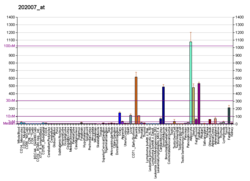(Redirected from Entactin)
Clinical significance
edit
- ^ a b c GRCh38: Ensembl release 89: ENSG00000116962 – Ensembl, May 2017
- ^ a b c GRCm38: Ensembl release 89: ENSMUSG00000005397 – Ensembl, May 2017
- ^ "Human PubMed Reference:". National Center for Biotechnology Information, U.S. National Library of Medicine.
- ^ "Mouse PubMed Reference:". National Center for Biotechnology Information, U.S. National Library of Medicine.
- ^ Olsen DR, Nagayoshi T, Fazio M, Mattei MG, Passage E, Weil D, Timpl R, Chu ML, Uitto J (June 1989). "Human nidogen: cDNA cloning, cellular expression, and mapping of the gene to chromosome Iq43". Am. J. Hum. Genet. 44 (6): 876–85. PMC 1715653. PMID 2471408.
- ^ Zimmermann K, Hoischen S, Hafner M, Nischt R (May 1995). "Genomic sequences and structural organization of the human nidogen gene (NID)". Genomics. 27 (2): 245–50. doi:10.1006/geno.1995.1038. PMID 7557988.
- ^ Smith J, Ockleford CD (January 1994). "Laser scanning confocal examination and comparison of nidogen (entactin) with laminin in term human amniochorion". Placenta. 15 (1): 95–106. doi:10.1016/S0143-4004(05)80240-1. PMID 8208674.
- ^ Ockleford CD, Bright N, Hubbard A, D'Lacey C, Smith J, Gardiner L, Sheikh T, Albentosa M, Turtle K (October 1993). "Micro-Trabeculae, Macro-Plaques or Mini-Basement Membranes in Human Term Fetal Membranes?". Phil. Trans. R. Soc. Lond. B. 342 (1300): 121–136. doi:10.1098/rstb.1993.0142. PMID 7904354.
- ^ Yurchenco PD, Patton BL (2009). "Developmental and pathogenic mechanisms of basement membrane assembly". Curr. Pharm. Des. 15 (12): 1277–94. doi:10.2174/138161209787846766. PMC 2978668. PMID 19355968.
- ^ "Entrez Gene: NID1 nidogen 1".
- ^ Yi XY, Wayner EA, Kim Y, Fish AJ (March 1998). "Adhesion of cultured human kidney mesangial cells to native entactin: role of integrin receptors". Cell Adhes. Commun. 5 (3): 237–48. doi:10.3109/15419069809040294. PMID 9686320.
- ^ "OMIM Entry - % 609222 - DANDY-WALKER MALFORMATION WITH OCCIPITAL CEPHALOCELE, AUTOSOMAL DOMINANT; ADDWOC". www.omim.org. Retrieved 2020-01-06.
- ^ McNiven, Vanda; Ito, Yoko A.; Hartley, Taila; Kernohan, Kristin; Miller, Elka; Care4Rare Canada; Armour, Christine M. (May 2019). "NID1 variant associated with occipital cephaloceles in a family expressing a spectrum of phenotypes". American Journal of Medical Genetics. Part A. 179 (5): 837–841. doi:10.1002/ajmg.a.61095. ISSN 1552-4833. PMID 30773799. S2CID 73507129.
{{cite journal}}: CS1 maint: numeric names: authors list (link)
- ^ Adam S, Göhring W, Wiedemann H, Chu ML, Timpl R, Kostka G (September 1997). "Binding of fibulin-1 to nidogen depends on its C-terminal globular domain and a specific array of calcium-binding epidermal growth factor-like (EG) modules". J. Mol. Biol. 272 (2): 226–36. doi:10.1006/jmbi.1997.1244. PMID 9299350.
- ^ Tran H, VanDusen WJ, Argraves WS (September 1997). "The self-association and fibronectin-binding sites of fibulin-1 map to calcium-binding epidermal growth factor-like domains". J. Biol. Chem. 272 (36): 22600–6. doi:10.1074/jbc.272.36.22600. PMID 9278415.
- ^ Pan TC, Kluge M, Zhang RZ, Mayer U, Timpl R, Chu ML (August 1993). "Sequence of extracellular mouse protein BM-90/fibulin and its calcium-dependent binding to other basement-membrane ligands". Eur. J. Biochem. 215 (3): 733–40. doi:10.1111/j.1432-1033.1993.tb18086.x. PMID 8354280.
 Article Images
Article Images






